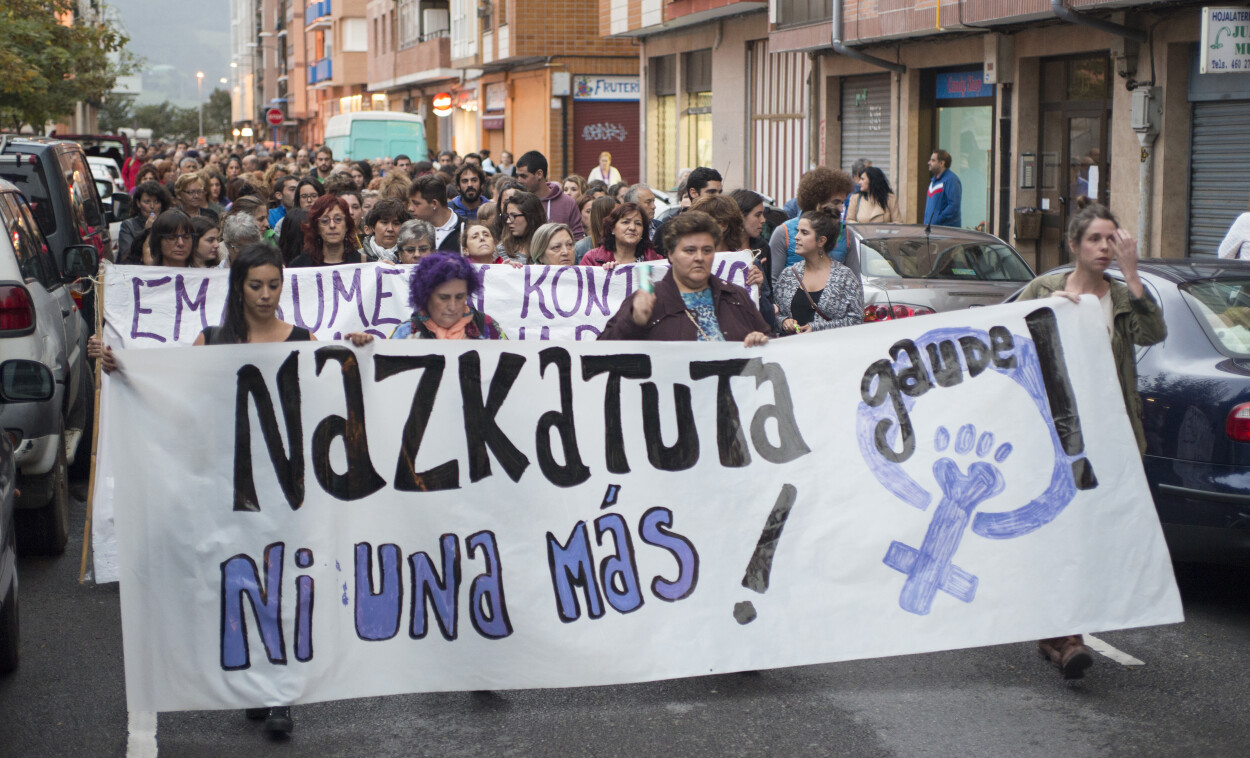Stings: machista attack, even if they do not cause chemical submission
- The arrival of the phenomenon of stings has sounded the alarm, but contrary to what was initially believed, according to the information that has been made known over time, it is unlikely that the stings provoke a chemical submission. This does not become a false alarm: the testimonies of several women show that punctures occur and that, therefore, the aggression is true, since with or without inoculation, the puncture continues to attack from the range that is a gesture full of meanings and that seeks to influence the woman. With the treatment of the phenomenon carried out by the media, however, the alarm has been channeled in a direction that affects women more: the focus has been placed on women and a report has been imposed that feeds the fear of male violence.

The stings have been complied with in recent weeks both with media owners and tertulians, as well as with colloquial interviews. The phenomenon started in the UK in 2021 has given way, and after its expansion in several European countries, the wave of stings has reached us. In addition, in the summer season, the festivities of cities, towns and neighborhoods are concentrated. That is, at the time of the year when the contexts in which the Machian aggressions increase are multiplied. In a festive environment characterized by the tendency to disinhibition, oppressive attitudes are reinforced, such as that of women, coming up with socially rooted logics, such as that of the public space belongs to men and that the space proper to women is the private space. For something, the feminist movement has been claiming that night, street and parties are not only masculine, but also ours.
In the opinion that this patriarchal logic feeds on it – that public space belongs to men – there are not many who have denounced the media treatment that has been made of stings. In early August, for example, Bilgune Feminist expressed concern through social media, that the alarm message that is spreading of opinion feeds the fear of male violence, which is a limitation of women’s freedom. This was confirmed by researcher expert in the field, Nerea Barjola Ramos, in an interview given to El Salto: “It creates fear of what can happen to you: it constantly alerts you instead of enjoying your free time. And in this situation of alert there is a cut in women’s rights”. Terror causes women to stop moving freely, occupying space, dressing, throwing themselves ...
Sexist microphysics of power. Alcásser eta lurra sexuala eraikiz (Sexist microphysics of power. The Alcasser case and the construction of sexual terror. Barjola, author of the essay Virus, 2018), analyzes the influence of the treatment of the Alcàsser case on the women of the time: “The narrative created around the forced disappearance of the three girls talked about borders that should not be crossed and spaces that should not be occupied (going out at night, traveling alone, hitchhiking), to turn the story about sexual terror into a warning and a demonstrative punishment. Thus, social, media and political discourses on crime were organized as patriarchal counter-attacks in the face of the conquest of the feminist movement and the spaces of freedom for women in general”. The author delves into the functioning of what he has called sexist microphysics of power from the concrete case of Alcàsse, which he understands as power dynamics, which uses the story of sexual terror as a mechanism of discipline for women.
Nerea Barjola: “[The treatment being done of the puncture] It creates fear of what can happen to you: it alerts you constantly instead of enjoying your free time. And in this situation of alert there is a reduction in women’s rights”
Questioning whether the treatment of the phenomenon of stings, like that of Alcás, is a new form of sexual terror, Barjola answered affirmatively in the interview given to El Salto, adding the following: “According to this representation of sexual terror, it is always us [women] who have to worry so that nothing bad happens to us, and if something bad happens to us the responsibility is ours. But the responsibility should not be ours, but yours [of men]. They are the ones who should not occupy public space for the terrorist sex they provoke from an hour.”
Stings, inducing chemical submission?
The alarm generated by the phenomenon of stings largely corresponds to the possible chemical submission that punctures can produce. In contrast to the first convictions, stings do not normally imply chemical submission. This has been pointed out in recent times by various sources, although with some of them Barjola has been very demanding: “Some drug experts reproduce subtly the lack of credibility with women.” It suggests that, irrespective of whether or not chemical submission occurs, stings are occurring, to which the recognition of the truthfulness of the word of the women who have denounced the stings must be given importance.
But there are also associations working from that point of view and from a feminist point of view. So we can read Ailaket! Association of drug users and ex-users for risk reduction: “We do not question the truthfulness of the stings because the testimonies of the victims are there, but chemical submission in most of the reported cases is not very viable. Because the aggressor has simpler, safer (for him) and much more common ways of sexually assaulting a woman.”
In almost all reported puncture cases, the tests have not detected any substance injected for submission purposes. And, as Ailaket has nuanced! !, “all psychoactive substances likely to be used for chemical submission are detected for at least the following eight hours”
Concerned about the media treatment of stings, and that presents them with the help of chemical submission, Ailaket! has released clarifying information. It states that in almost all cases of reported puncture tests have not detected any substance injected for submission purposes. And they have clarified that “all psychoactive substances that may be used for chemical submission are detected, at least for the next eight hours.” More data have also been provided that lead to dismantling the alleged link between stings and chemical submission: on the one hand, the use of a syringe requires knowledge that anyone does not have, “even more so if it is used in unclear areas and the victim is in motion”; on the other hand, that the time needed to inject the substance capable of causing the described effects is several seconds, not immediate; and that, among other things, when it is a complaint of an incidence of a
From a criminological point of view, if it is understood that the purpose of the aggressor is to take advantage of the vulnerability of the victim, the puncture strategy is not very coherent. In fact, stings have been carried out on women who are surrounded by people and the effects of substances allegedly injected are so immediate that submission does not occur in a context that favors sexual aggression or other crime. “In the hundreds of cases reported in Spain there have been no attacks or robberies, so the goal of chemical submission is not happening,” says Ailaket!
The association has also made public the data that come to dismantle the imaginary of the chemical submission that has spread with the treatment of the phenomenon of stings. According to the report that has been constructed, the usual procedure is that the woman in the festive area is stung by a stranger, and the psychoactive substance inoculated by this puncture causes the effects of chemical submission (dizziness, tiredness, etc.) to be noticed in a quarter of an hour. ), becoming in a vulnerable situation. However, in addition to emphasizing that chemical puncture submission is unlikely, Ailaket! has explained how usual chemical submission is carried out: alcohol, the most standardized drug, is the most common substance in chemical submission cases, and most chemical submission aggressions are usually opportunistic. In other words, the usual thing is for the aggressor to use a situation of vulnerability caused by psychoactive substances voluntarily consumed by the victim. And this is because in most cases the aggressor is known to the assaulted.
With or without inoculation, the sting continues to be attacked, as it is charged with meaning and seeks to influence the woman
Aggression without inoculation
Although the knowledge that chemical submission is unlikely to be triggered by puncture may be relaxing, it should not take away severity from the phenomenon. Both with inoculation and without inoculation, as the sting continues to be attacked, as it is loaded with meaning and seeks to influence the woman. Maria Sánchez-Ramos eldiario.es clearly explains this: “Could a woman’s puncture not be such an aggression? Does it not intend to inoculate fear in our flesh? It's a demonstration of male strength, control and power. You can translate the meaning of the needle into the words “I don’t get you, but I could do it,” and the warning is given to a woman, but also to everyone to tell us what our place is.”
Bi erizainetatik batek lanean eraso sexistak jasaten dituela azalerazi du Erizainen Ordenak joan den urte bukaeran egin ikerketak. 21.000 erizainek ihardetsi dute, sektore pribatu, publiko eta liberaletik. Hauetan 2.500 gizonak dira.
Today, the voices of women and children remain within a culture that delegitimizes their voices, silencing their experiences, within a system aimed at minimizing or ignoring their basic rights and needs. A media example of this problem is the case of Juana Rivas, but her story... [+]














.jpg)




